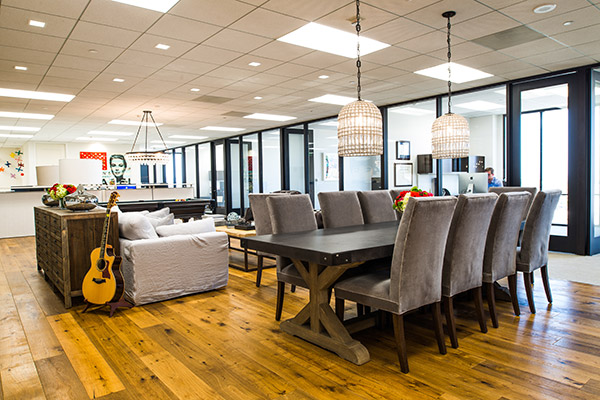The overwhelming trend in commercial office space toward more open, collaborative areas for employees, with fewer partitioned work spaces and even fewer enclosed offices, appears to be here to stay.
But it’s also fairly new, meaning it’s worth taking a look at just how functional these wide open work areas are for employees. Does the ability to easily talk, brainstorm and chat with colleagues really lead to a free-flowing exchange of ideas? Possibly. Does having an open office save money, by reducing the square footage needed per employee? Absolutely. But does this trend serve as a catalyst for increased productivity?
According to one recent study, the answer is a resounding no.
According to research conducted by Jungsoo Kim and Richard de Dear of the Center on the Built Environment at the University of Sydney, the open-office plan that has become so wildly popular these days has its fair share of drawbacks. The chief problem? Productivity suffers when employees struggle to concentrate in noisy spaces with minimal privacy.
According to Kim and de Dear, nearly 50 percent of employees in open-office plans and nearly 60 percent of employees seated at workstations with partitions cited the lack of sound privacy as the most frustrating aspect of their work environment.
This begs the question: Is the open-office model worth it? Kim and de Dear’s research found that employees in open-office areas or cubicles are not only dissatisfied by their inability to prevent co-workers from hearing what they say but also by not being able to control what they hear from others.
Other studies conducted by psychologists and research organizations have arrived at similar findings. In contrast, those with enclosed offices reported the least amount of frustration with their office environment and were therefore the happiest employees.
But with millions of commercial real estate square feet already embracing open collaborative spaces and more springing up each year, what should employers do if they find that office productivity is less than desirable?
Sound Solutions for Open Office Spaces
There is no doubt that open-office spaces can appear very cool. Employees can see one another and easily access colleagues for impromptu brainstorming sessions. Yet, in the Kim and de Dear study, “ease of interaction” was a problem for less than 10 percent of employees, whether they were in an open-office space or an enclosed space.
Indeed, when opening the doors of a new company or relocating quarters or just optimizing a current space, be sure to include breakout rooms (or small public areas).
Even employers committed to having the look of an open, trendy office space should enclose at least a couple of offices. Pair or group employees in some of these offices, if necessary, but be sure some quiet spaces are available.
Employees need to be able to speak in private or make phone calls that the entire office doesn’t hear. They also need distraction-free areas to focus on complex assignments. Even if the company can enclose only a single conference room or two small offices, some space needs to have four walls and a door.
Consider installing a white noise machine to ensure sound privacy in breakout areas or conference rooms. Granted, these machines still generate noise, but this type of noise is less distracting than hearing co-workers chatting or having a meeting next to the breakout or conference room.
If spending 10 percent more on enclosed spaces leads to 20 percent greater productivity, the initial investment will pay for itself over the long haul. Spending a bit more on tenant improvements or rent to create an environment that’s more functional can lead to greater satisfaction among employees, which can prompt higher retention of staffers and lower hiring and training costs.
Moving or Expanding Offices
When it’s time to renew a lease or move from an existing office, be sure to work with a tenant representative to ensure the highest possible tenant improvement allowance. This way, the company can invest in at least a few enclosed offices, in addition to breakout spaces. The investment will be worthwhile as earlier research from Kim and de Dear found that “the loss of productivity due to noise distraction … was doubled in open-plan offices compared to private offices, and the tasks requiring complex verbal process were more likely to be disturbed than relatively simple or routine tasks.”
There is nothing wrong in wanting to provide an office atmosphere that promotes unity and encourages collaboration by team members. But the unintended consequences of an open plan should be considered. I’ve seen many companies switch to open-office spaces only to find that employees start wearing headphones to block out noise.
Studies have indicated that employees wearing headphones while working (whether for listening to music or blocking noise) might lead to decreased productivity and an inability to concentrate. Furthermore, the use of headphones adds a deterrent to collaborative interaction among employees, possibly defeating the purpose of the open-plan office.
Many reasons may prompt the pursuit of ample space for gathering, brainstorming and team building in an office. But balance is vital to long-term success. By balancing open spaces with enclosed areas, a company may find that the investment is more than worth it and will pay dividends in increased employee satisfaction and productivity.
This article originally appeared on Entrepreneur.com.
Tucker Hughes is managing director at Hughes Marino, a global corporate real estate advisory firm that exclusively represents tenants and buyers. As head of Hughes Marino’s Orange County and Los Angeles offices, Tucker specializes in tenant representation and building purchases throughout Southern California. Tucker makes frequent media appearances to speak on the future of commercial real estate, and is also a regular columnist for Entrepreneur.com. Contact Tucker at 1-844-662-6635 or tucker@hughesmarino.com.











